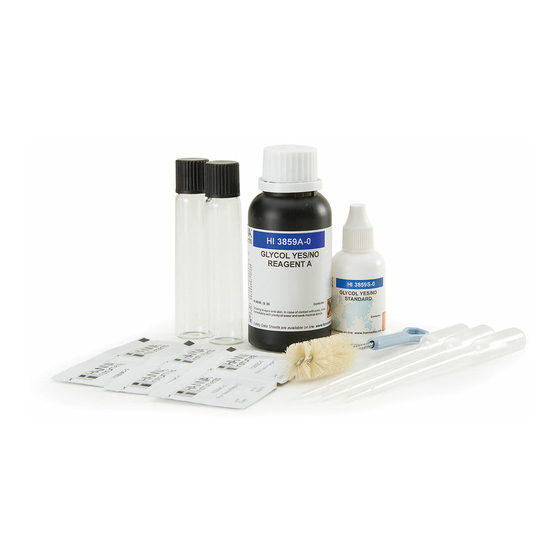
Advertisement
Quick Links
Instruction Manual
HI 3859
Glycol Yes/No
Test Kit
www.hannainst.com
SPECIFICATIONS
SPECIFICATIONS
SPECIFICATIONS
SPECIFICATIONS
SPECIFICATIONS
Dear Customer,
Thank you for choosing a Hanna Product. Please read the
instructions carefully before using the chemical test kit. It
will provide you with the necessary information for correct
use of the kit.
Remove the chemical test kit from the packing material and
examine it carefully to make sure that no damage has
occurred during shipping. If there is any noticeable dam-
age, notify your Dealer or the nearest Hanna office
immediately.
Each kit is supplied with:
• HI 3859A-0 Glycol Yes/No Reagent, 1 bottle (125
mL);
• HI 3859B-0 Glycol Yes/No Reagent, packets (25 pcs);
• HI 3859C-0 Glycol Yes/No Reagent, packets (25 pcs);
• HI 3859 Glycol Standard 0.025%, 1 bottle with
dropper (25 mL);
• 1 plastic pipette (3mL), for HI 3859A-0 Reagent;
• 25 plastic pipettes (1 mL);
• 2 glass vials (10 mL) with cap;
• 1 brush.
Note: Any damaged or defective item must be returned
in its original packing materials.
SPECIFICATIONS
SPECIFICATIONS
SPECIFICATIONS
SPECIFICATIONS
SPECIFICATIONS
Range
The test detects traces of glycol
above 30 ppm
Analysis Method
Visual/Appearance of color
Sample Size
0.5 mL
Number of Tests
25
Case Dimensions
235x175x115 mm (9.2x6.9x4.5")
Shipping Weight
380 g (13.4 oz.)
SIGNIFICANCE AND USE
SIGNIFICANCE AND USE
SIGNIFICANCE AND USE
SIGNIFICANCE AND USE
SIGNIFICANCE AND USE
Ethylene glycol is widely used as a coolant and antifreeze.
Its presence in motor oils is an indication of a perforated
engine block or of a leakage in the cooling systems. The
Hanna Glycol test kit can be used for water as well as oil
samples to determine traces of ethylene glycol and other 1,2
glycols above 30 ppm. For better results test samples from
used motor oil: samples from new oils can give erroneous
positive results. Never test oils from hot engines. Use the HI
3859 Glycol Standard 0.025% included in the Kit to easily
recognize a positive result in the form of an intense purple
color.
Note: mg/L is equivalent to ppm (parts per million).
Note:
Note:
Note:
Note:
CHEMICAL REACTION
CHEMICAL REACTION
CHEMICAL REACTION
CHEMICAL REACTION
CHEMICAL REACTION
Ethylene glycol and other 1,2 glycols are determined by a
two step reaction:
Step 1: glycol is oxidized to two carbonyl groups under
acidic conditions;
Step 2: the carbonyl groups react with the indicator in
the HI 3859C-0 reagent powder packet to give a
colored solution.
INSTRUCTIONS
INSTRUCTIONS
INSTRUCTIONS
INSTRUCTIONS
INSTRUCTIONS
READ THE ENTIRE INSTRUCTIONS BEFORE USING THE KIT
Note: to learn how to recognize the pres-
ence of glycol you can use the HI
3859 Glycol Standard 0.025%.
Procedure: add 10 drops of HI 3859
Glycol Standard 0.025% to 0.5 mL
of your sample and follow the in-
structions below: an intense purple
color will develop.
• Unscrew the cap of the glass vial
and fill it with 5 mL of HI 3859A-0
reagent to the mark using the 3
mL plastic pipette. Add 0.5 mL of
your sample using the 1 mL plastic
pipette.
• Add the content of one packet of HI 3859B-0 reagent,
replace the cap and mix until any solid element is
totally dissolved.
• Wait for 20-25 minutes or place the vial in hot tap
water for 5 minutes.
• Carefully unscrew the vial and add one packet of HI
3859C-0 reagent; replace the cap and mix well until
the reagent is completely dissolved.
• Wait for 75 minutes at room temperature or place the
vial in hot tap water for 20 minutes.
• Detect the presence/absence of glycol in your sample by
the color developed:
ppm of glycol
Color
0-30
yellow-brown
30-75
light purple
more than 75
dark purple
Note: always wait for the final color to be developed. Colors
can turn from
yellow to colorless to light purple (for low range
glycol)
orange to grey/green to dark purple (for high range
glycol)
Note: before performing a new test, rinse thoroughly the
vial under water and clean it by means of the brush
with some soap.
Warning: HI 3859B-0 and HI 3859C-0 reagents can be
disposed as ordinary refuse. HI 3859A-0 reagent
and the content of the vial after use are generally
classified as special wastes. Arrange disposal with a
Chemical Disposal company or contact your Local
Authorities for advice.
REFERENCES
REFERENCES
REFERENCES
REFERENCES
REFERENCES
"Advanced Organic Chemistry", J.March, 4
ed. Wiley
th
Interscience.
HEALTH AND SAFETY
HEALTH AND SAFETY
HEALTH AND SAFETY
HEALTH AND SAFETY
HEALTH AND SAFETY
The chemicals contained in this test kit may be hazardous if
improperly handled. Read Health and Safety Data Sheets
before performing the test.
Advertisement









Need help?
Do you have a question about the HI 3859 and is the answer not in the manual?
Questions and answers